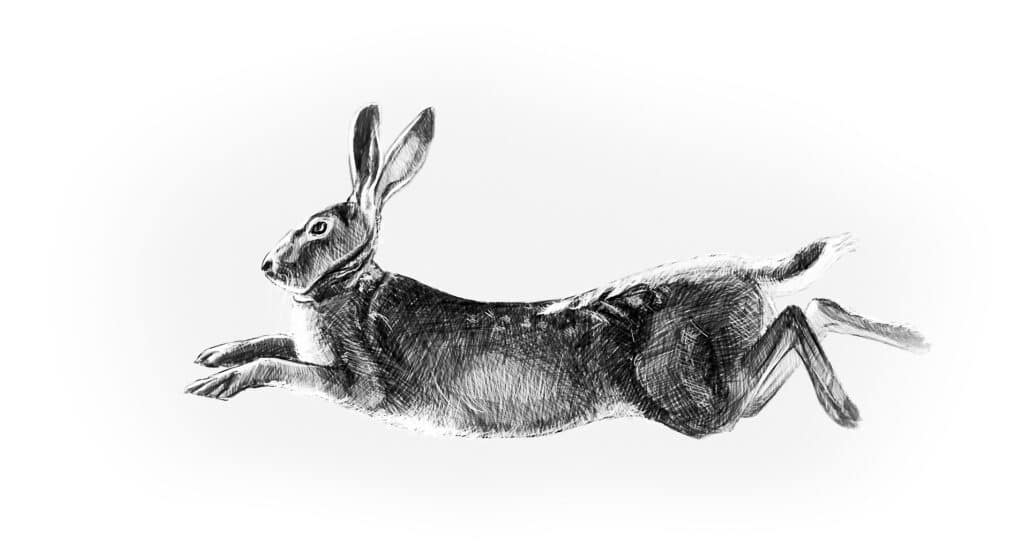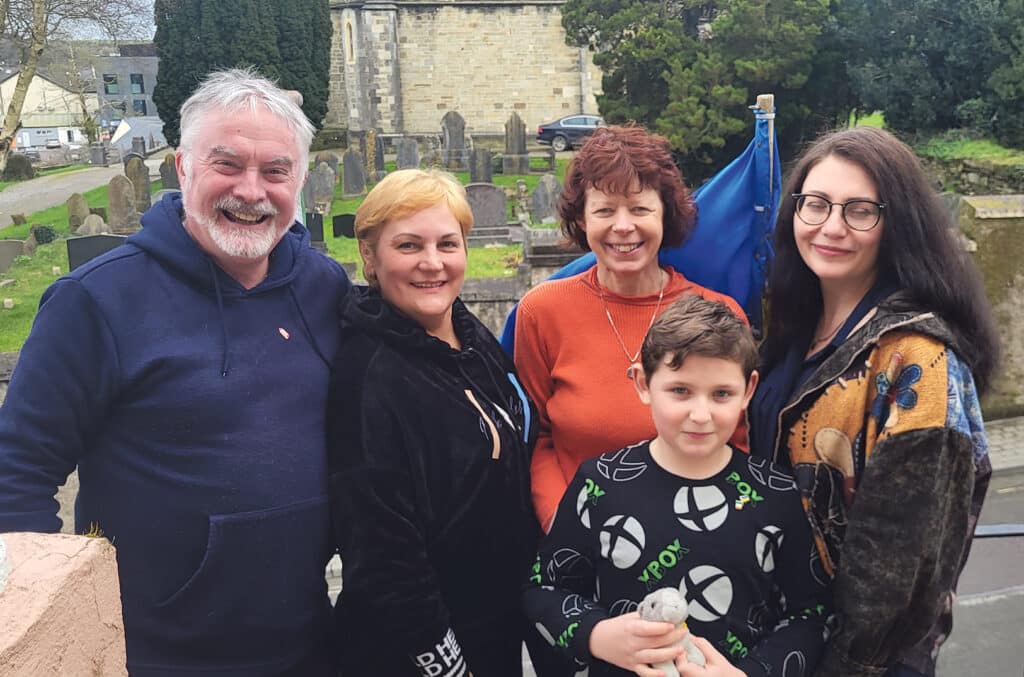
Noted in Irish folklore for its swiftness, alertness and agility, the hare was also regarded as a fairy animal associated with deception and witchcraft. In myth, the hare was linked to Celtic goddesses of fertility, both of spring and of the harvest.
One widespread belief among Irish country people was that witches would travel in the form of a hare to steal milk, especially on May Day. The most common version of the story tells of a dairy farmer who became suspicious when the milk yield of his cattle diminished considerably. He began to stay up at night to watch the cows, and soon saw a hare come and drink the milk from them. The farmer’s dog gave chase, but succeeded only in drawing blood from its hindquarters as it fled. The farmer followed on and, coming to a nearby house, he asked the old woman who lived there if she had seen the hare. Despite the woman’s denials, the farmer noticed that she was bleeding from her leg, and so realised that the hare had been the woman in disguise. For this reason, in the past any hares found among the cattle on May Day would often be killed by farmers. Farmers would sometimes try to prevent the theft from taking place. For example, it was the custom to sprinkle the fields with holy water on May morning. One story tells how a farmer accidentally sprinkled a hare hiding in the grass. As soon as the holy water touched the hare, it turned into an old woman crouched down in terror, caught in the act.
The hare was also associated with the end of the harvest. Traditionally one sheaf of corn was left uncut, and it was believed that a hare hid in it, only making a dash for safety at the very last minute. Finishing the harvest was called ‘putting the hare out of the corn’, and the farmer who was late with the harvest was told: ‘we sent you the hare’. Finishing the harvest was also called ‘putting out the ‘cailleach’ (hag)’. One story tells how the hag hid (in hare form) in the last sheaf, and was driven from farm to farm as the farmers finished the harvest, until she reached the field of the last man in the parish to cut his corn. In many parts of Ireland the last sheaf itself was called the hag or ‘cailleach’ for this reason.
There are many Irish proverbs about hares that emphasise its speed and alertness. To say ‘Tabhair do phóg do chois an ghiorria’ (kiss the foot of the hare) meant to say goodbye to something for ever. ‘Codladh an ghioria’ (the hare’s sleep) meant to sleep lightly, ‘with one eye open’. According to another Irish proverb, the three traits of the hare were a keen ear, a bright eye and a quick run. An old belief dating from classical times was that the hare always sought shelter under the sow-thistle (bleachtán mín), widespread in cultivated and waste ground.
Hares appear sometimes in Irish folk tales and myths, usually in the context of hunting. According to one legend, Mannanán Mac Lir, the Irish god of the sea, led King Conchubhar of Ulster to the hiding place of the maiden Deirdre by running before his hounds in the form of a hare (This is part of the tragic love story of Deirdre and the Sons of Usna, perhaps the best known love story in Irish mythology). Part of the training of the Gaelic hero, Fionn Mac Cumhaill, was to keep hares in a field by successfully running before them, whichever way they went. Later, hares were among the animals hunted by the Fianna, and one poem tells of a prodigious week’s hunting, when a total of six hundred hares were killed.
There is evidence that the hare was sacred in Celtic Britain. A well-known remark by Julius Caesar in his work ‘De Bello Gallico’, stated that the ancient Britons regarded hares as sacred and taboo as food. Boudicca, the British Celtic warrior queen, was said to have released a hare while invoking ‘Andraste’, goddess of battle and victory, before setting out to defeat the Romans in battle.
Hares were generally linked to the spring because of the prominence of the ‘mad March hares’, namely the male hares which compete with each other in sparring matches at this time.
Hares were involved in several folk cures and probably because of their speed, their feet were considered especially potent. In Ireland it was thought that the paw of a hare hung around the neck on May Day would cure ailments such as cramp and rheumatism. In England a hare or rabbit’s foot was considered lucky, especially by sailors and fishermen, and it was used to brush the baby’s face and so ward off evil spirits.
However traditionally the hare was regarded as an unlucky and even sinister animal. This idea is probably due to its nervousness and wildness, which caused man to associate it with the insecure and unknown side of his own nature. The Irish word for a hare (giorria) originally meant ‘little wild one or even little deer’. Because it lived in the wilderness and avoided humans, the ancient Irish regarded the deer as a strange animal which consorted with otherworld beings, and they saw the hare in a similar light. It was said that fairies could take the form of hares, an all-white hare being especially suspect.
This was a riddle about the hare: A hopper of ditches, a cutter of corn, and a brown little cow without any horns. There are many sayings about the hare; ‘as swift as a hare’ and ‘it’s hard to drive the hare from a bush she’s not in’.
Sir William Wilde, father of Oscar Wilde, observed with regard to the widespread superstitions concerning the hag-hare which milked cows, especially on May morning when the door to the world of spirits is most open: “On May day if they find a hare among their cattle, they endeavour to kill her out of a notion that it is some old witch that had a design upon their butter”.
Paradoxically, it was unlucky to kill a hare before sunrise. If one met a hare when setting out on a journey one should turn back as the hare presaged some unlucky happening.
Those who hunted hares often had strange experiences. Here is an example from folklore: Long ago there lived a man in this district by the name of O’Sullivan. He was very fond of hunting and used to spend much of his time out on the hills with his hounds. One day when he was out a beautiful hare rose before him. The dogs gave chase and O’Sullivan, who was very fleet of foot, followed behind. The chase lasted for hours, but in the evening the hare disappeared. O’Sullivan turned for home but at that moment he heard someone calling him. When he turned around he saw a beautiful lady, dressed in white, standing on a rock. The lady said to him: ‘Why do you follow my hare?’ O’Sullivan said that he thought that the hare was not owned by anyone. These words seemed to please the lady and taking a mug of milk she gave it to him and said: ‘Take a drink for I know you are thirsty’. When O’Sullivan put the mug to his lips he was changed into a bird and he flew back to his own house. When the woman of the house saw the bird, she caught it and killed it. The man then returned to his own form again and he told her the whole story.
In another story two huntsmen and their dogs were walking near a graveyard. One of the dogs ran into the graveyard, killed a hare, and returned to its owner with the hare in his mouth. The man took the hare and brought it home. After a while he got a severe pain in his hand, and he was treated by the best doctors. No cure was found, with the result that in time his hand withered and rotted off his body. He died soon afterwards and the storyteller concluded that it was the general view in the locality that there was something unhealthy in that hare.
If a pregnant woman encountered a hare, it was believed that her child might be born with a fissure in the upper lip, a harelip. To avoid the hare-lip, it was advised that such a woman should tear the hem of her dress, thus transferring the destined fissure to another object.
Another story from West Cork concerning the ‘cailithín’, or white hare, goes as follows: A very long time ago there lived in the townland of Reavouler, Drinagh, a ‘cailithín’. This ‘cailithín’ was a white hare and he lived in a druid’s fort. It was supposed to be a witch in the shape of a hare. The owner of this fort had seven cows, and each evening when his wife went to milk them out in the field, the hare came to the opposite side of her and sucked nearly a bucket of milk.
One day, a pack of huntsmen came to hunt this mysterious hare; they had hounds who could catch a hare at a distance of three or four hundred yards. When they came to the fort, the hare started out. When the hounds saw it, they seemed reluctant to follow it, but on being urged on by the huntsmen, they started off in pursuit. Away then they rushed over hills, bogs and meadows with the horses and huntsmen close behind shouting and urging on the hounds. The hare jumped across a river into a rushy meadow where it hid itself from the hounds. The horses and hounds sprang across after it and they searched the meadow over and over again but they found no trace of the mysterious hare. However, there was one clump of rushes which they had not yet searched. As they approached it, a large bird, the like of which they had never seen, flew out and with a weird scream, went upwards into the air. On the other side of the river was a little mound on which the bird alighted. The huntsmen gazed at each other and when they turned again to the mound, there sat the white hare looking as fresh as ever. Again they began the chase, and away they sped over bogs and meadows as before, with the huntsmen urging on the hounds.
When they came to the druid’s fort, the hare, with one jump, sprang over the fence and sat in the entrance hole. When the huntsmen came up, the hare disappeared down the hole. The huntsmen set the dogs after it, and then they heard some scrambling in the entrance hole, and a moment later there stood there a dog about the size of a large goat, with large hanging ears and eyes as big as saucers. It grinned so horribly that the huntsmen and hounds took fright and no one ever since chased the ‘Cailithín’.



